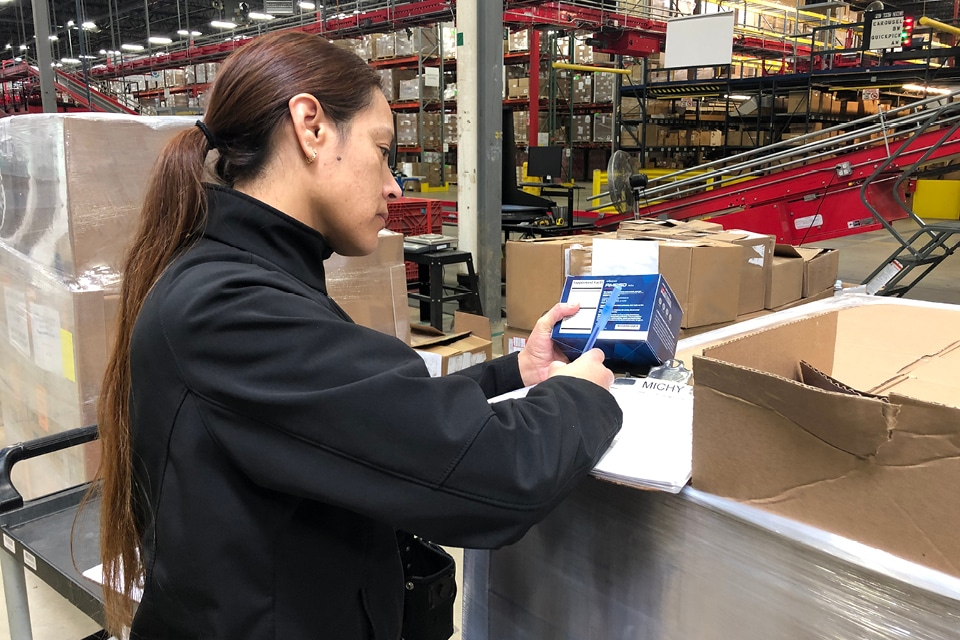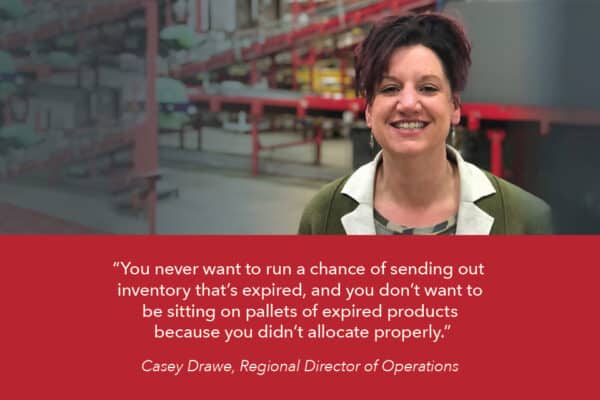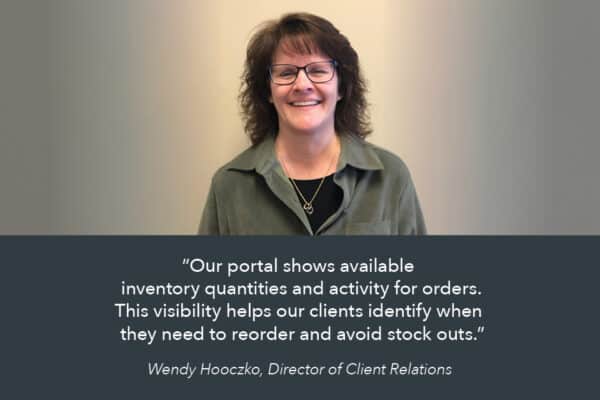7 Factors that Affect Inventory Accuracy – and how to improve them

Warehouse errors including mis-shipments and picking errors come with a high cost to both business profitability and customer loyalty. According to Multichannel Merchant’s research, a fulfillment error has an average cost of between $35 and $50. Mis-shipments usually result in returns which can significantly impact profitability as well as create logistical challenges. Then, there are additional customer service costs. Frequent shipping errors lead to lower customer satisfaction and loyalty. In today’s competitive ecommerce environment, it’s more important than ever to provide outstanding customer experiences.
For these reasons, we gathered two of our supply chain experts, Casey Drawe, Regional Director of Operations and Wendy Hooczko, Director of Client Relations to share their thoughts on inventory control, factors that affect inventory accuracy and some key metrics to measure.
What is inventory control?
Let’s start with the basics. Inventory control is the process of receiving, storing and consuming a company’s inventory. As a fulfillment services provider, we are entrusted to receive, store, pick and ship that inventory accurately, safely and efficiently. Here are some of the core principles we follow to ensure we manage our clients’ inventory responsibly.
Factors that affect inventory accuracy
1. Accuracy begins at the receiving dock.
Properly receiving inventory into your warehouse operation is critical for inventory accuracy. “We place our best team members on the receiving dock – this is the first line of defense to ensure inventory accuracy,” shared Casey. This includes visual inspection on all inbound shipments, confirmation that proper items and quantities are received against the purchase order and packing slip, and identification of any damages.
From a process standpoint, if inbound shipments aren’t already labeled, a warehouse management system will generate a pallet identifier or license plate from an advanced shipping notice. Upon receipt, we label the inbound shipments, scan the license plate and confirm the quantities. Overages, shortages or damages are communicated to clients so that they are immediately aware and can inform suppliers and instruct final dispositioning for receipt.
If you don’t identify any issues on the front end, those discrepancies will impact the entire lifecycle for those items in your warehouse.
2. Inventory allocation methods are an important consideration.
The two most common examples are first expiration first out (FEFO) or first in first out (FIFO). Depending on the product and industry, these methods are important to drive expiration date for items with a shelf life or warranty dates.
A warehouse management system captures this information and allocates inventory based upon these business rules. This includes replenishment of forward pick so that you consume the newest product first. This is important in controlling obsolescence.

Controlled visibility to your inventory is also a part of accuracy. For example, lot control provides traceability for any recall, rework or quarantine required for that inventory.
3. Accurately capture all possible units of measures – for inbound receipts and outbound orders.
Many items may be received in different units of measure than they are shipped. For items that are packed in case quantity, a warehouse management system should be able to track inventory at the unit level within that case.
It begins with the set-up of your item master. If an item is received as a case but picked as an “each,” this needs to be identified when the item is set-up in the system. The warehouse management system will store back stock as cases. When the inventory is moved into the primary pick location, it converts the unit of measure to pieces for the location. Then when you go to the pick location, the system will tell you what unit of measure the item should be picked.
Imagine shipping one case to a consumer’s home instead of the one piece they ordered. Avoiding mis-picks due to the correct unit of measure ensures a happy customer and a more profitable company.
4. Warehouse layout.
There are basic rules that are important to avoid any human error. Inbound receipts and outbound shipments should operate from separate doors to ensure received inventory doesn’t immediately get reshipped. Separate back stock from forward pick locations to avoid picking from multiple locations, creating an opportunity for broken cases and obsolescence. If there are similar items or SKUs, ensure that they are not stored closely together and be sure all locations are clearly labeled to avoid picking errors. But remember, the best safeguard against picking errors is to leverage your warehouse management system and directed picking solutions.
5. Your warehouse management system is your pickers’ best friend.
“A good warehouse management system will guide workers’ actions and help to reduce errors,” says Casey, “which is critical to inventory accuracy, order accuracy and happy customers.” A warehouse management system will drive pickers to locations systemically. We use radio frequency (RF) scanners to aide our picking. Pickers scan the tote; the system then guides the workers to the right location where another scan takes place. The item is picked, each item is individually scanned and then placed in the tote where a final scan takes place – confirming the right items and quantities were picked for that order.
If a worker scans the wrong barcode, they are alerted that the wrong location or item has been selected. This alert not only takes place during picking, but also when our replenishment teams move inventory from back stock to forward pick locations. Any movement is captured by our system to ensure we are maintaining the integrity of the inventory. We also have traceability by employee so that we understand where additional training may be required.
Some companies’ items do not include barcodes. In those situations, we either offer to apply a barcode label or as an alternative to barcoding each item, we bar code the shelf at the pick location. The location barcode is scanned at the time of pick instead of the item to confirm the correct item.
6. Communication.
Proper communication with your warehouse operations or third-party fulfillment provider is key. Advanced shipment notifications alert the warehouse of the items and quantities expected to arrive on that shipment so any variances can be identified. If new items are introduced or suppliers change for an item, work to communicate that in advance. Understanding new items in advance avoids needless delays or questions during receiving. New suppliers may package products with different case quantities. Early visibility of these changes avoids variances or adjustments after receiving.
7. Visibility.
Real-time visibility to inventory is critical for more accurate and timely decisions. Our Partner Portal provides a window into the inventory we manage. Clients have the ability to enter orders there as well. “I often use the portal to discuss inventory balances with our clients,” shares Wendy. Our portal shows available inventory quantities and activity for orders. It also tracks inbound inventory. This visibility helps our clients identify when they need to reorder and avoid stock outs.”

What are some key inventory metrics companies should track?
- Order accuracy or fill rate – Lines shipped versus lines ordered. How accurately your warehouse processes your orders. According to the Warehouse Education and Research Council, best in class accuracy is 99.89%. Consider incorporating directed picking solutions with your warehouse management system to get the right product to your customers.
- Obsolescence – Obsolescence tracks inventory items that don’t move. In 90 days, if you haven’t sold a product, then you know to adjust your purchase behavior. Understand how your inventory allocation and item master can impact obsolescence.
- Shrinkage – Shrinkage is when a product goes damaged or missing. It’s defined as a percentage of inventory or dollar amount. According to the Warehouse Education and Research Council, the median is <0.5%. Identify issues upon receipt and let your warehouse management system guide your workers to avoid errors.
These all come down to knowing what you have and where you have it. We advise clients to create a plan for inventory that isn’t moving so they’re not paying for unnecessary warehouse space.
Here are some key takeaways
- Inventory management processes should be specialized to your products and business.
- Warehouse layout and technology can help improve inventory accuracy.
- Communicating with your operations team or logistics partner is key to making sure all processes function efficiently.
- You should find a partner that allows you to have a good handle on your data.
- Don’t forget cycle counting and velocity. This is your double-check that your inventory systems are performing properly. We are happy to review your velocity and recommend the proper cycle count program for your business.
Inventory control is not only about the correct allocation of product and an efficient supply chain process, but also the customer experience and customer satisfaction. Inventory accuracy starts at the receiving dock and requires clear communication between a client and their 3PL partner. Proper warehouse practices all lead to the end customer having a positive experience, which will benefit all involved: Your brand’s reputation depends on it. It’s critical that the customer receives exactly what they ordered, on time and undamaged.
Please contact our team with any questions. Our supply chain experts are happy to consult with you on how to provide a fulfillment solution to meet your specific needs.
FIDELITONE helps you earn customers’ loyalty through specialized services in inbound logistics, order fulfillment, last mile delivery and service parts management.
Recent Posts
-

A Guide to a Successful B2B Fulfillment Operation
Amazon’s global marketplace offers an incredible opportunity to showcase your products and brand to a…
-

How To Control or Minimize Costs When Using Fulfillment By Amazon (FBA)
Amazon’s global marketplace offers an incredible opportunity to showcase your products and brand to a…
-

What to Look for When Choosing a 3PL for Your Supplement Business: Key Considerations for Supply Chain Leaders
As a vitamin and supplement company, having an efficient and scalable supply chain is critical.…
Are you interested in order fulfillment or last mile delivery services? Consult with a FIDELITONE expert to discuss how we can help.
